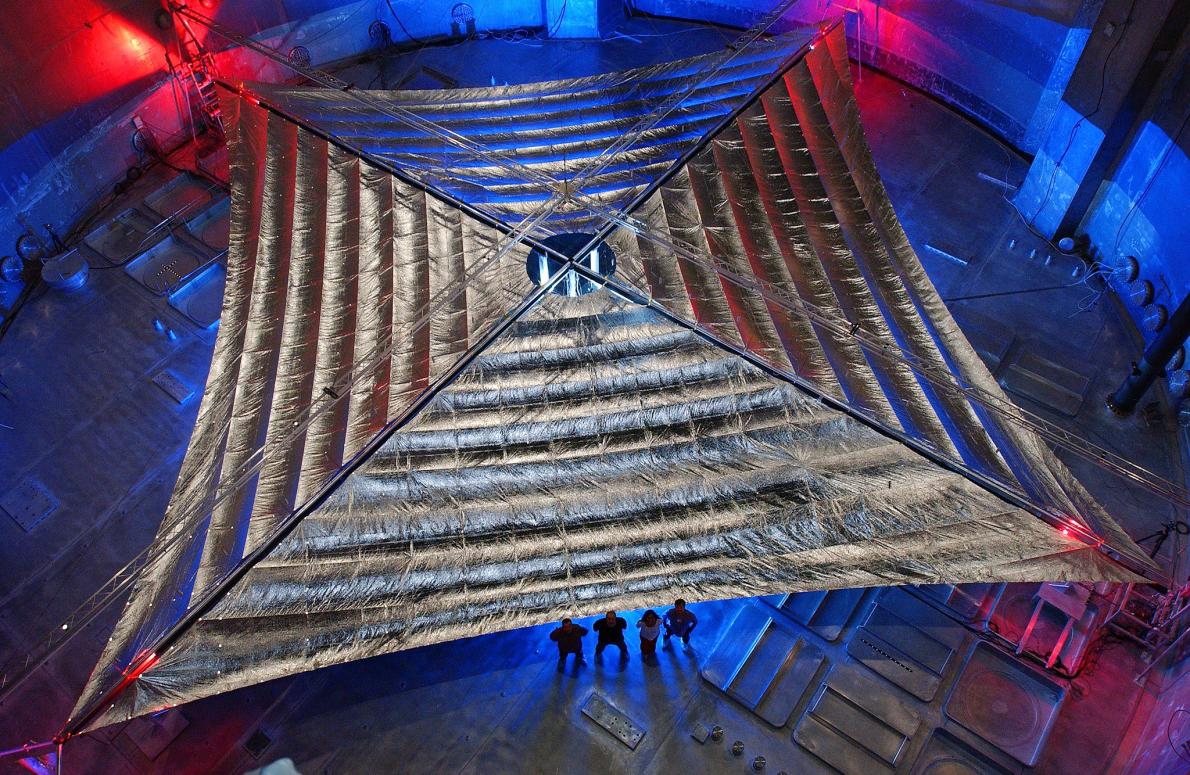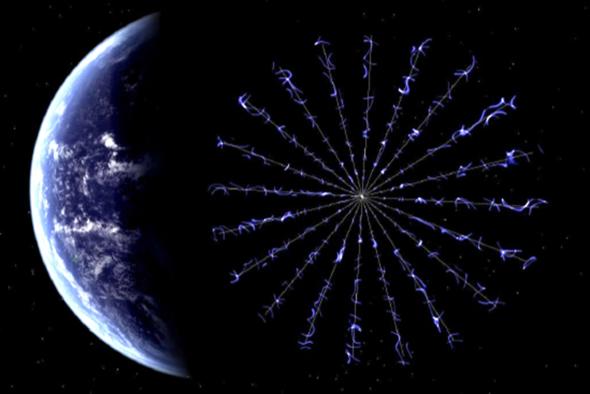
In 1418, the European sailing ships left their ports, to explore the Atlantic ocean, and began the era of Great geographical discoveries. In 2018 a small space probe will deploy a sail and embark on a journey to the distant asteroid. This will be the first NASA spacecraft that is moving outside the Earth’s orbit solely by sunlight. This technology may pave the way to affordable Solar system and eventually interstellar space.
Probe the Near-Earth Asteroid Scout $ 16 million dollars is among the 13 precious cargo, NASA announced the other day. They all go along with the official start of Space Launch System is a large missile, designed to replace space shuttles, which one lucky spacecraft Orion to Mars.
You will need 2.5 years to NEA Scout has reached the destination, a small asteroid 1991 VG. But it will not be a relaxed cruise. Continuous traction will be provided by the sunlight hitting a solar sail, and it will drive the probe to a speed of 103 000 km/h relative to the Sun.
After a certain time the spacecraft equipped with solar sails can accelerate more than the spacecraft of this size using conventional chemical rockets.
“Sail wins the race from the point of view of the finite speed of the turtle passes the hare, says Les Johnson, the technical Advisor for advanced concepts NASA Goddard space flight Center. Marshall. Chemical rocket provides a huge initial thrust, but ultimately burns its fuel. — As the sail does not use any fuel, we are able to maintain traction while the sun shines”.
Lightweight material
Solar sails are made from ultra-thin material with high reflectivity. When a photon of sunlight falls on a mirrored surface, it bounces off the sail and transmit their momentum space machine — in the same way a cue ball transfers its momentum when it collides with another ball on the table.
The idea of solar sails has existed since 1924, when the legend of Soviet rocketry Konstantin Tsiolkovsky and Zander Fridrik conceived spacecraft, “using tremendous mirrors of very thin sheets” and “the pressure of sunlight to attain cosmic velocities”. Forty years later the science fiction writer Arthur C. Clarke popularized the idea in his novel “solar wind”.
NASA is beginning to invest in the technology of solar sails in the late 90’s. In 2010, the Agency successfully launched sailing small satellite into Earth orbit, where he stayed for 240 days, until he entered the atmosphere and burned up.
In the same year, the Japanese space Agency have demonstrated the possibility of using solar sails for interplanetary travel. The test apparatus is fastened to Board the Venus probe “akatsuki”. The spacecraft with solar sail called IKAROS was opened to the space probe when he was at 7 million kilometers from Earth. Six months later, IKAROS successfully passed by Venus.

Solar sails were made possible thanks to the revolution in electronics.
The fact that the solar sail project is a kind of a hostage of the second law of motion Newton: force equals mass multiplied by acceleration. The power of solar light is constant, so to achieve high acceleration you will need low weight.
“25-30 years ago electronics were not so easy, says Johnson. — It was impossible to imagine the construction of quite a small spacecraft which do not need a huge sail. With the advent of smartphones and the miniaturization of components, we can now make a really light and small spacecraft, which means he’ll need to sail a reasonable size”.
Johnson gives the example of a CubeSat — tiny satellites-cubes, constructed of “ready to use” technologies. NEA Scout will be a CubeSat the size of a shoebox, which will push a solar sail with an area of 86 sq. m.
Despite its modest size, the probe is Packed a sufficient amount of tools to conduct extensive studies of the asteroid 1991 VG, photographing and measuring the chemical composition, size, and motion of the object.
NASA sees in this exploration is an important first step to future manned missions to asteroids. If an astronaut is going to explore the surface of a space rock, NASA wants to be assured that rotates slow and predictable way, and not spins in different directions. Similarly, the space Agency wants to know in advance how hard the asteroid or represented by a pile of stones held in by gravity.
The movement of light
During its mission, NEA Scout will carry out at least one slow approach to close the distance — he slows down to 10 meters per second, and the device will be half a kilometer from the surface of the asteroid. This points to another advantage of solar sails: they are very maneuverable, and sometimes even surpass traditional methods of movement.
The key to management of sail — be it Atlantic ocean or space — lies in creating asymmetrical thrust. There are many different ways to create one, using the heavenly equivalent of the masts and rigging. IKAROS has an electro-optical coating that darkens when voltage is applied by absorbing light, not reflecting it. You can thus customize the part of the sail so that it is received two times less than the sun than the other, and deploy the device.
NEA Scout will use a different approach, using a sliding mechanism that moves back and forth CubeSat relative to frames, on which the sail is deployed.
“If you imagine a jar of coke, which will be our unit, and place on top of a sheet of paper flat it will sail, says Johnson. — Then imagine that you just physically move the sheet left and right. Here’s the way it is”. The inclination of the sails also allows you to adjust the speed.
The flexibility of a spacecraft with a solar sail in combination with the constant draught, thanks to the inexhaustible stock of fuel — opens the way to a few interesting possibilities.

Let’s say you want to send a probe above the Ecliptic plane of the Solar system to explore the North pole of the Sun. To dramatically change direction and speed without using precious fuel engineers usually rely on a gravity-assist maneuver. “Now we must send a spacecraft to Jupiter for a gravitational maneuver to take him out of the Ecliptic plane and get a higher angle orbit around the Sun, says Johnson. — Sail will be enough to send him up.”
Other potential uses are already closer to home, is “sitting on the pole” of the satellite. Now, if you want to lock the satellite in a certain position in relation to the place in the world — and it would be very useful for communication technologies — you can only send it to a geostationary orbit above the equator, to a height of 35 786 kilometers above the Earth.
But with a sail “you can be over North or South pole of the Earth and rotate around the Sun with the same speed with which Earth revolves around the Sun, says Johnson. — To overcome the gravity of Earth, enough to send the sail to push you up all the time. Thus, you will hang motionless above the North or South pole”.
Positive energy
Photons which we see as sunlight is not the only fuel for a spacecraft, produced by the Sun. NASA scientists recently received additional funds to study advanced concepts of ultrafast sails, driven by charged particles in the solar wind.
It’s called electric sail, e-sail. This idea was first proposed Janhunen Pekka, researcher at Finnish meteorological Institute. He presented the device is surrounded by the finest wires 20 of 20 kilometers each.
These wires generate positively charged electric field, stretching for tens of meters into space. The protons of the solar wind, travelling at a speed of over 750 kilometres per second, are repelled by this electric field, in response to pushing the spacecraft. Negatively charged particles of the solar wind extinguished a kind of “electronic cannon”, so the electric sail supports a positively charged electric field.
Electrophorus will have a lot of fuel. If the solar light pushing a solar sail, much diminished, when the spacecraft reaches the asteroid belt, the solar wind is still blowing strongly. Over time, electrophorus can be accelerated to 100-150 km/s.
This means that space probes can reach Jupiter in just two years or five Pluto. Electrophorus can provide completely new possibilities for exploration, to allow us to implement rapid journey beyond the Solar system, in interstellar space.
“Voyager 1 spacecraft” it took 35 years to reach the boundaries of the Solar system. The solar sail would have carried out this tour for 20 years, and electrophorus — 10.
“I must admit, two and a half years ago, when my boss came to me and said, “we want you to look at this,” I frankly neighing, says Bruce Wegmann, system engineer at NASA. — Then we looked and said, well, very interesting. Have gone from unbelieving to believing”.
Actually, Wegmann believes that the prototype can be run in just five years. But have to solve a few important issues. Although electrophorus not need fuel, they need a powerful energy source for electron gun, which repels the electrons. How much energy? Depends on the number of electrons, which collects electrophorus. NASA experts are studying this question using a charged wire in the plasma chamber, simulating the solar wind.
Another problem is to prevent bending of the long thin wire as exposure to the solar wind. Solution: rotate the machine at a speed that will provide enough centrifugal force that the wires remained strained.
Next stop: alpha Centauri
Outside NASA the Forest Johnson has another job: he writes fiction. Actually, he is thankful to the novel “the Mote in the eye of God” in 1974 for a revival of interest in solar sails.
No wonder he’s dreaming about the distant future. He wants solar sail headed into another solar system.
“We could build a big laser, he says. — As the sail moves away from the Sun and sunlight becoming less and less, can be illuminated with the light of the laser, continue. The laser will remain in orbit of the Sun, continuing to disperse sail faster and faster until he leaves the Solar system”.
Of course, remain technical challenges that need to be addressed. First, the sail must be the size of Texas. And orbital laser would have to produce energy, the amount of which can be compared with the one that produces the entire world today. Sounds, of course, but for a hundred years, much can be done.
The first space ship built by humans and sent to another system may arrive there as its oceanic ancestors during the age of discovery: beneath its sails unfurled, reaching for the stars.
